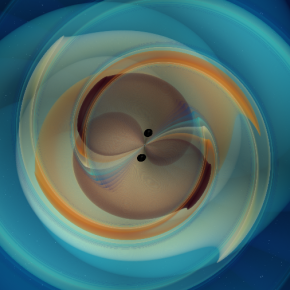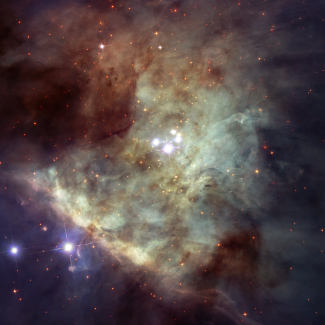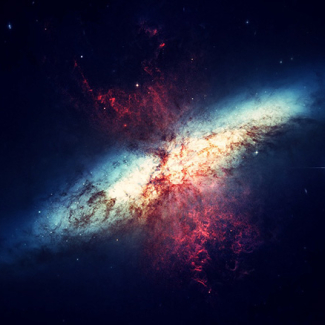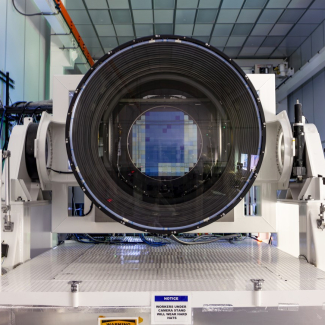
New populations of black holes revealed by gravitational waves
The gravitational wave1 detectors LIGO and Virgo have just chalked up their biggest catch yet, a black hole 142 times the mass of the Sun, resulting from the merger of two black holes of 85 and 65 solar masses. The remnant black hole is the most massive ever observed with gravitational waves, and it could give us some clues about the formation of the supermassive black holes that sit at the centres of some galaxies. The mass of one of the merging black holes, 85 solar masses, provides information that could improve our understanding of the final stages in the evolution of massive stars. The discovery, to which several CNRS teams contributed as part of the Virgo collaboration, is published on 2 September 2020 in the journals Physical Review Letters and Astrophysical Journal Letters.
- 1Gravitational waves are ripples in space-time, predicted by Albert Einstein in his theory of general relativity in 1915 and detected for the first time a century later.
At first sight, there is nothing particularly new about the detection of the birth of a black hole caused by the merger of two others, accompanied by the emission of a huge amount of energy: after all, a succession of similar events have been observed ever since 2015, when the gravitational waves produced by such phenomena were observed for the first time2 . However, GW190521, the signal recorded on 21 May 2019 by the LIGO and Virgo instruments, stands out from the crowd, for the signal is not only the most distant, and therefore the oldest, ever detected (the gravitational wave took seven billion years to reach us), but in addition the black hole resulting from the merger is also the most massive observed so far. Above all, the observation is the first direct evidence of the existence of ‘intermediate-mass’ black holes, which weigh in at 100 to 100 000 solar masses. Such intermediate-mass black holes are heavier than those resulting from the collapse of high mass stars, but much lighter than the supermassive black holes that sit at the centre of some galaxies. Until now, only indirect evidence obtained from electromagnetic observations hinted at their existence.
Intermediate-mass black holes are interesting since they may hold the key to one of the big puzzles in astrophysics and cosmology: the origin of supermassive black holes. Although the question remains an open one, one of the scenarios proposed to explain the formation of these cosmic monsters is precisely that of repeated mergers of intermediate-mass black holes.
With masses around 65 and 85 times that of the Sun, the two black holes that were observed to merge intrigue astrophysicists as well. This is because, based on our current knowledge, the gravitational collapse of a star cannot form black holes in the approximate range of 60 to 120 solar masses, since the most massive stars are completely blown apart by the supernova explosion that accompanies the collapse, leaving only gas and dust behind them. So, sitting right in the middle of this forbidden range, how did the black hole of 85 solar masses form? Is there something we haven’t understood about the way in which massive stars end their lives? If it is not of stellar origin, could it too have resulted from an earlier merger of less massive black holes? Or alternatively, could it be a hypothetical primordial black hole, formed during the Big Bang? The observation of GW190521 clearly raises new questions about the formation of the enigmatic objects we call black holes.
Compared to earlier observations, the GW190521 signal detected by LIGO and Virgo is very short and harder to analyse. Due to its more complex nature, other hypotheses involving more exotic sources were also explored to explain it, and such possibilities are described in the article in Astrophysical Journal Letters. However, the most plausible source of this gravitational wave remains the merger of two black holes.
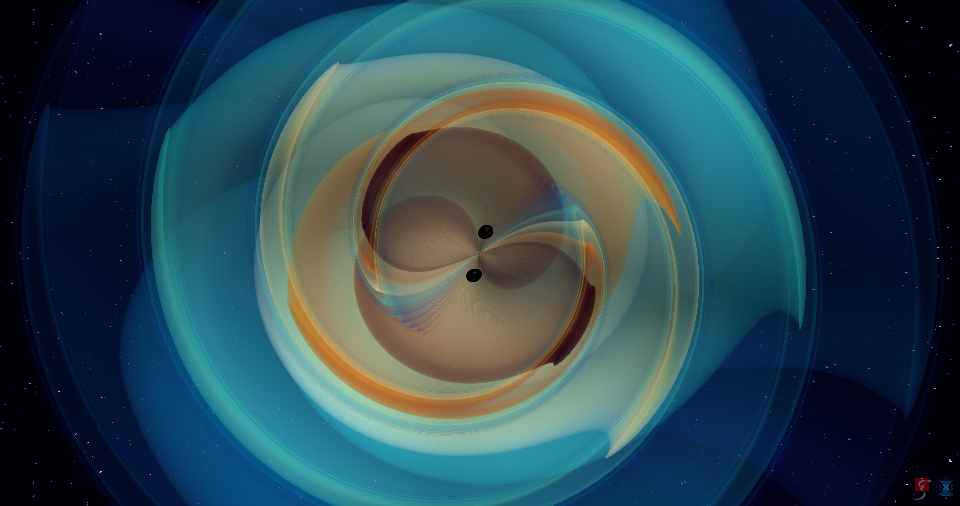
© N. Fischer, H. Pfeiffer, A. Buonanno (Max Planck Institute for Gravitational Physics), Simulating eXtreme Spacetimes (SXS) Collaboration
About Virgo and LIGO
The Virgo Collaboration is currently composed of approximately 580 members from 109 institutes in 13 different countries, including Belgium, France, Germany, Greece, Hungary, Ireland, Italy, the Netherlands, Poland, Portugal and Spain. The European Gravitational Observatory (EGO) hosts the Virgo detector near Pisa in Italy, and is funded by the French National Centre for Scientific Research (CNRS) in France, the Istituto Nazionale di Fisica Nucleare (INFN) in Italy, and Nikhef in the Netherlands. A list of the Virgo Collaboration groups can be found at http://public.virgo-gw.eu/the-virgo-collaboration/. More information is available on the Virgo website at http://www.virgo-gw.eu.
LIGO is funded by the National Science Foundation (NSF) and operated by Caltech and MIT, which conceived of LIGO and led the project. Financial support for the Advanced LIGO project was led by the NSF, with Germany (Max Planck Society), the U.K. (Science and Technology Facilities Council) and Australia (Australian Research Council-OzGrav) making significant commitments and contributions to the project. Approximately 1,300 scientists from around the world participate in the effort through the LIGO Scientific Collaboration, which includes the GEO Collaboration. A list of additional partners is available at https://my.ligo.org/census.php.
The scientific articles announcing this discovery are co-signed by 99 scientists in France, working in eight teams from the CNRS and associated universities, part of the Virgo Collaboration:
- 'Astroparticule et cosmologie' laboratory (CNRS/Université de Paris) ;
- 'Astrophysique Relativiste, Théories, Expériences, Métrologie, Instrumentation, Signaux' laboratory (CNRS/Observatoire de la Côte d’Azur/Université Côte d’Azur) ;
- 'Institut de physique des 2 infinis de Lyon' (CNRS/Université Claude Bernard Lyon 1) ;
- 'Institut pluridisciplinaire Hubert Curien' (CNRS/Université de Strasbourg) ;
- 'Institut lumière matière' (CNRS/Université Claude Bernard Lyon 1) ;
- 'Laboratoire d'Annecy de physique des particules' (CNRS/Université Savoie Mont Blanc) ;
- 'Laboratoire Kastler Brossel' (CNRS/Sorbonne Université/ENS-PSL/Collège de France) ;
- 'Laboratoire de physique des 2 infinis - Irène Joliot-Curie' (CNRS/Université Paris-Saclay).
Some of the authors are associated with the teams mentionned above while working in other laboratories: ‘Institut Foton’ (CNRS/Université Rennes 1/Insa Rennes), Lagrange laboratory (CNRS/Université Côte d’Azur/Observatoire Côte d’Azur), ‘Laboratoire de physique et d'étude des matériaux’ (CNRS/Sorbonne Université/ESPCI Paris).
- 2Gravitational waves detected 100 years after Einstein's prediction: http://www2.cnrs.fr/sites/en/fichier/cp_cnrs_engcharte.pdf (press release), 11 February 2016; A Nobel for Gravitational Waves: https://news.cnrs.fr/articles/a-nobel-for-gravitational-waves (CNRS News, first published 11 February 2016, updated 3 October 2017)
GW190521: A Binary Black Hole Merger with a Total Mass of 150Mʘ, The LIGO Scientific Collaboration and the Virgo Collaboration, Physical Review Letters, 2 September 2020. DOI: 10.1103/PhysRevLett.125.101102
Properties and astrophysical implications of the 150Mʘ binary black hole merger GW190521, The LIGO Scientific Collaboration and the Virgo Collaboration, Astrophysical Journal Letters, 2 September 2020. DOI: 10.3847/2041-8213/aba493
In an effort to promote open science, the LIGO-Virgo Collaboration publishes data related to this discovery on: http://www.gw-openscience.org
